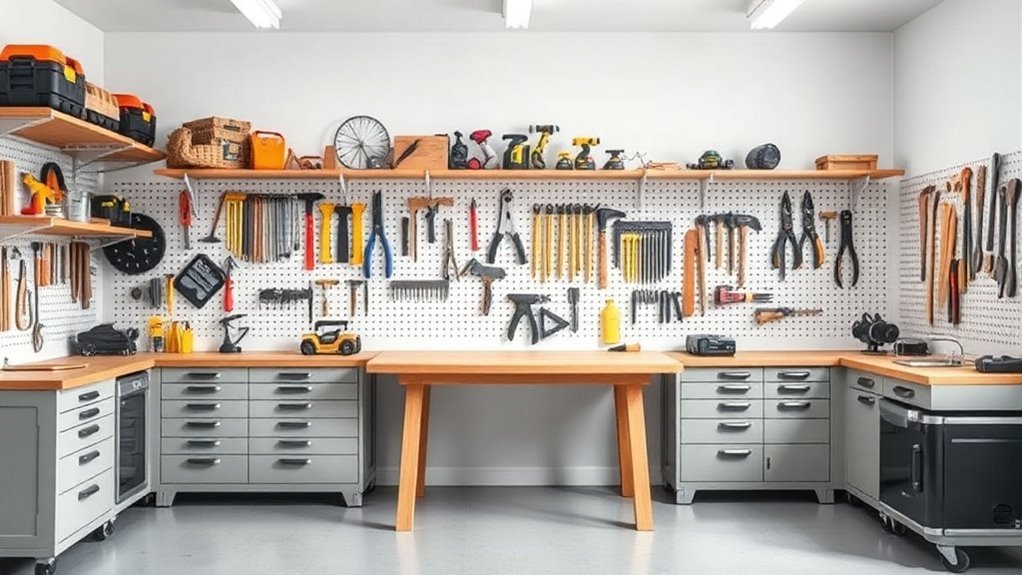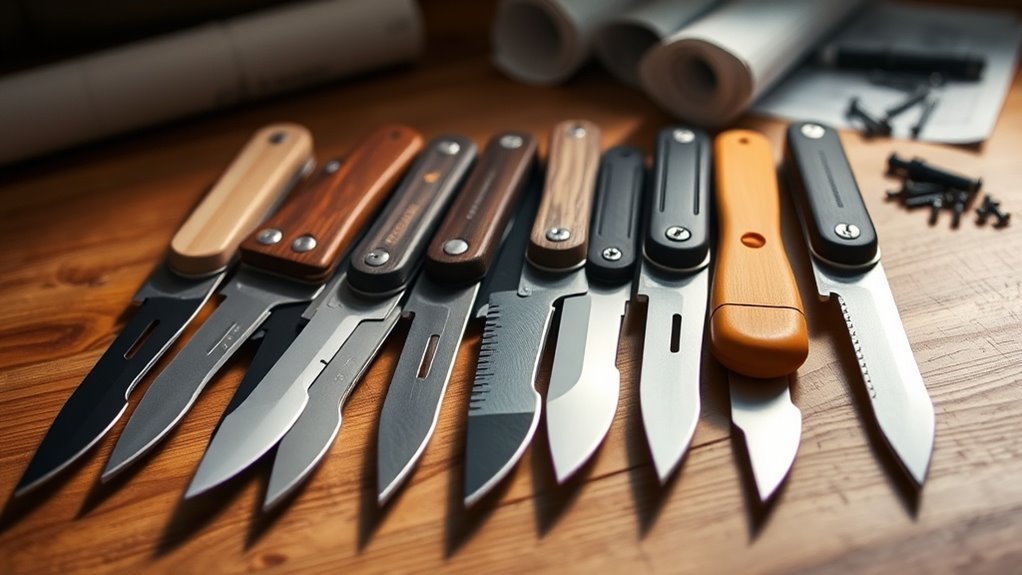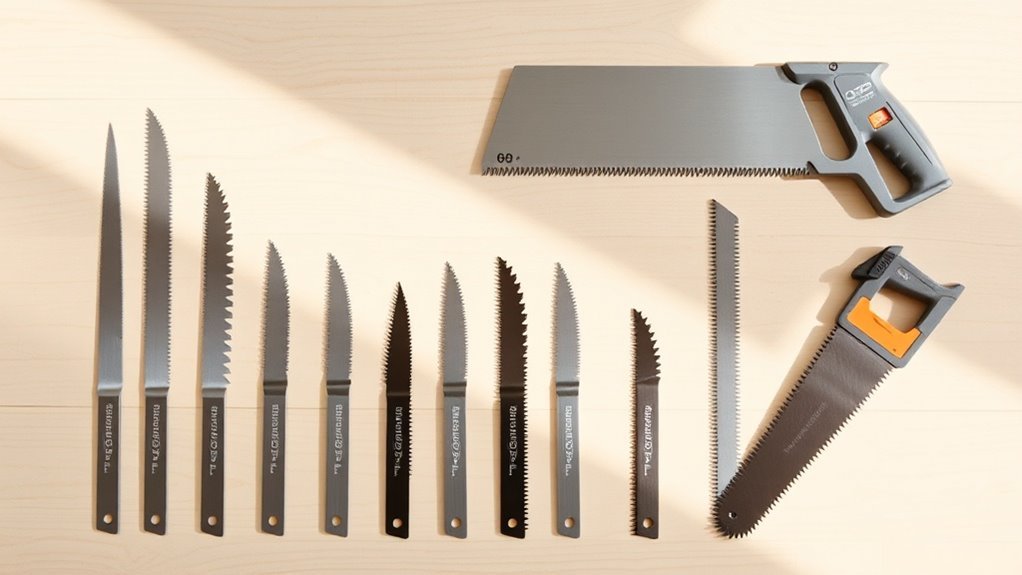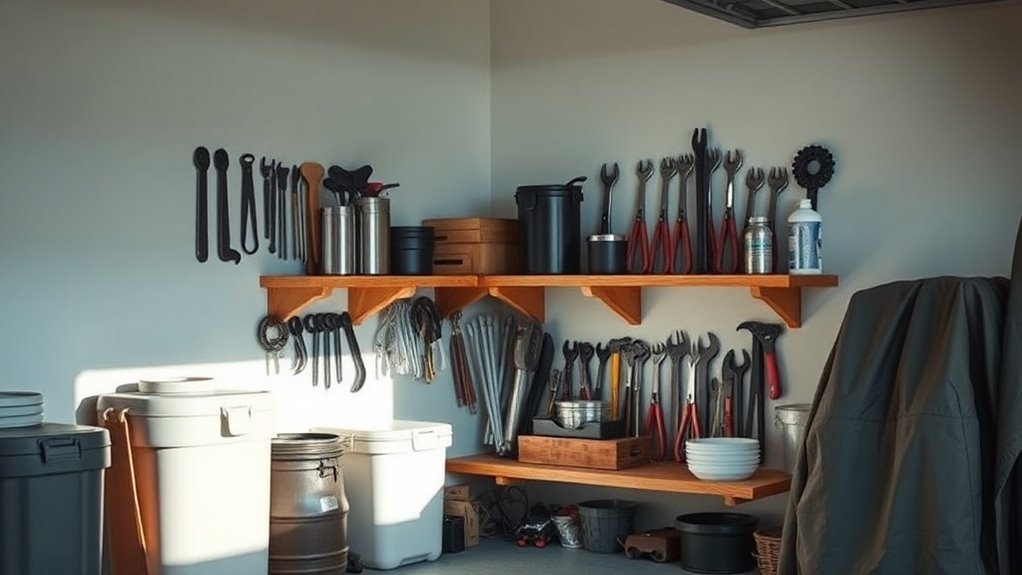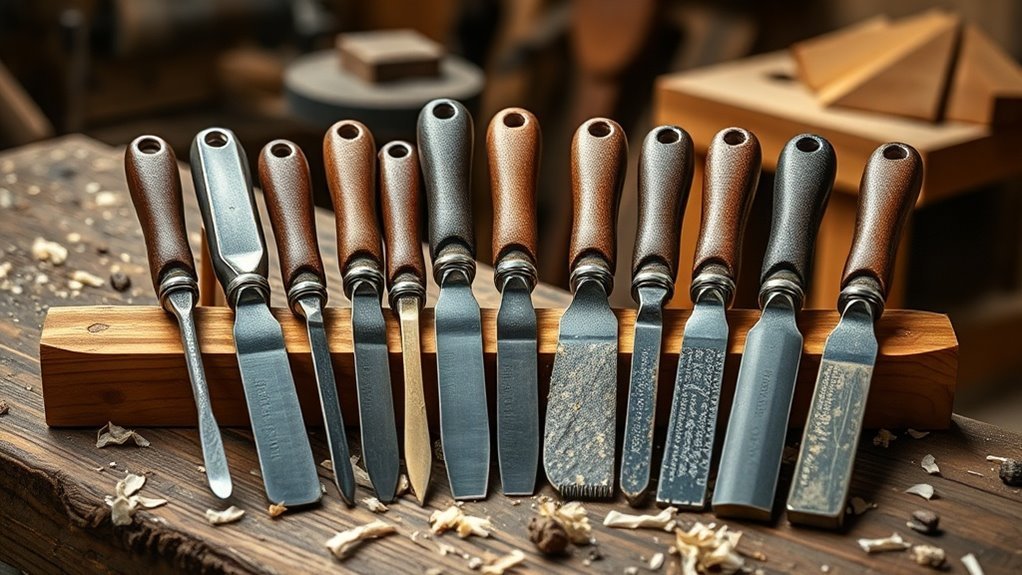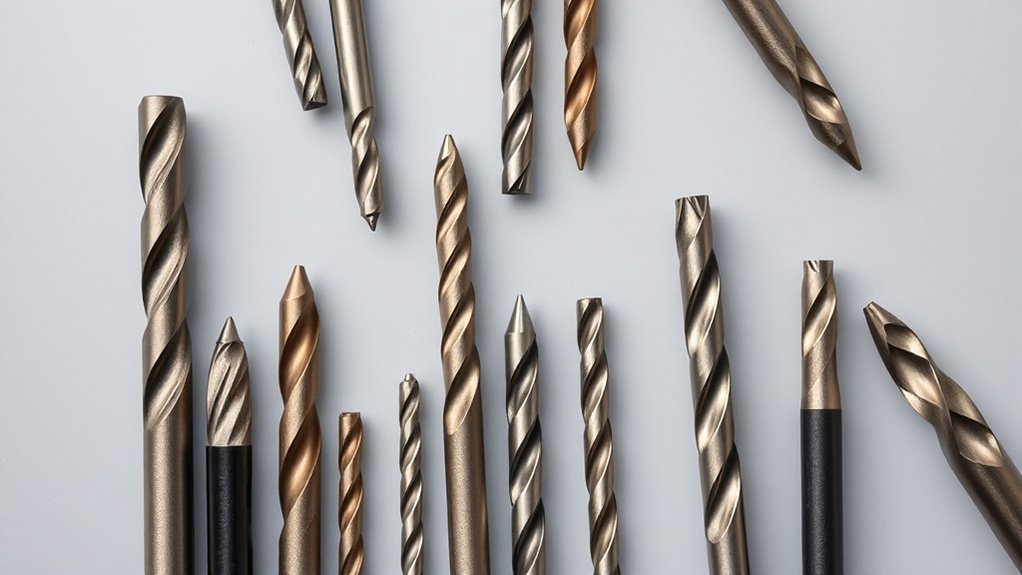Safety Guidelines for Using Sharp Hand Tools
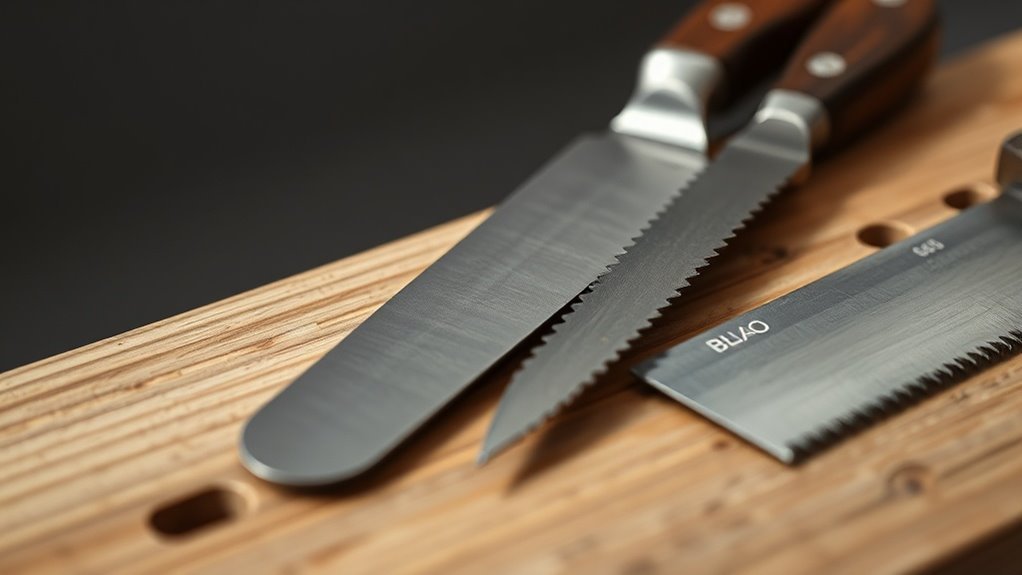
When using sharp hand tools, always prioritize safety. Choose the right tool for your task and maintain it regularly to prevent injuries. Wear appropriate PPE like cut-resistant gloves and goggles. Use proper cutting techniques, keeping your workspace organized and well-lit to minimize distractions. Secure your materials firmly and store tools properly after use. Stay aware of your surroundings to avoid accidents. There’s plenty more valuable information to help you stay safe with sharp tools.
Key Takeaways
- Always wear personal protective equipment (PPE), such as cut-resistant gloves and safety goggles, to minimize injury risk when using sharp tools.
- Keep your workspace well-lit, clutter-free, and non-slip to reduce chances of accidents and enhance stability while working.
- Regularly inspect tools for damage, sharpness, and cleanliness, and maintain them to prevent potential hazards during use.
- Secure materials properly and approach cuts at a slight angle to maximize leverage and control during cutting tasks.
- Focus on your work and avoid distractions; fatigue can significantly increase the likelihood of accidents with sharp hand tools.
Understanding the Risks of Sharp Hand Tools
When you work with sharp hand tools, it’s essential to recognize the potential risks involved. These tools can inflict serious injuries if not handled correctly, including cuts, punctures, or even amputations.
Understand that fatigue and distraction can increase your likelihood of accidents, so it’s critical to stay focused. Always inspect your tools before use; damaged or dull blades heighten the risk of mishaps.
Fatigue and distraction increase accident risk; stay focused and always inspect your tools before use to ensure safety.
Additionally, consider your surroundings; cluttered workspaces can lead to trips and falls. Wearing proper personal protective equipment, like gloves and safety goggles, is also fundamental. Using essential safety gear can significantly enhance your protection while you work.
Remember, safety should always be your top priority; never rush through a task. Cultivating respect for the tools guarantees you work efficiently while minimizing hazards.
Stay vigilant and aware.
Choosing the Right Tool for the Job
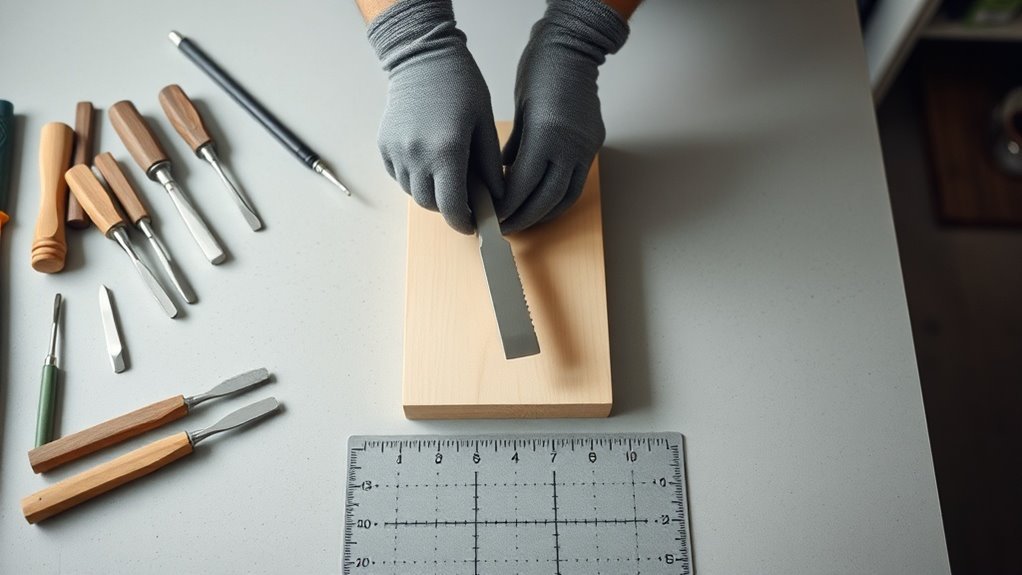
When it comes to working with sharp hand tools, choosing the right tool is essential for both safety and efficiency.
You’ll want to reflect on the type of tool that best fits the task at hand and the handle weight to guarantee you can control it comfortably. The versatility of utility knives can greatly expand your options for completing various tasks safely and effectively.
Making the right selections can help prevent accidents and improve your overall performance.
Tool Type Selection
Selecting the right tool for your task can make all the difference between a successful project and a frustrating experience. Understanding the specific requirements of your job will help you choose the ideal tool.
Consider these factors:
- Task type: Different tasks may require different tools—like a chisel for precise cuts or a hammer for driving nails.
- Material: Verify your tool is suited for the material you’re working with, whether it’s wood, metal, or plastic.
- Precision needed: For intricate tasks, opt for tools that offer greater control, like a craft knife.
- Safety features: Always check for safety features that can protect you while you work, such as a blade guard.
Handle Weight Consideration
After you’ve found the right tool based on task type, material, precision, and safety features, handle weight is another important aspect to evaluate. A tool that’s too heavy can lead to fatigue and decreased precision, while one that’s too light might not offer the control you need. It’s crucial to match the handle weight to your task and personal comfort.
| Tool Type | Lightweight Options | Heavier Options |
|---|---|---|
| Knives | Folding utility knife | Chef’s knife |
| Saws | Mini hand saw | Bow saw |
| Hammers | Claw hammer (12 oz) | Framing hammer (24 oz) |
| Screwdrivers | Precision screwdriver set | Heavy-duty screwdriver |
| Pliers | Needle-nose pliers | Channel-lock pliers |
Choosing wisely will enhance your efficiency and safety.
Maintaining Sharp Tools Properly
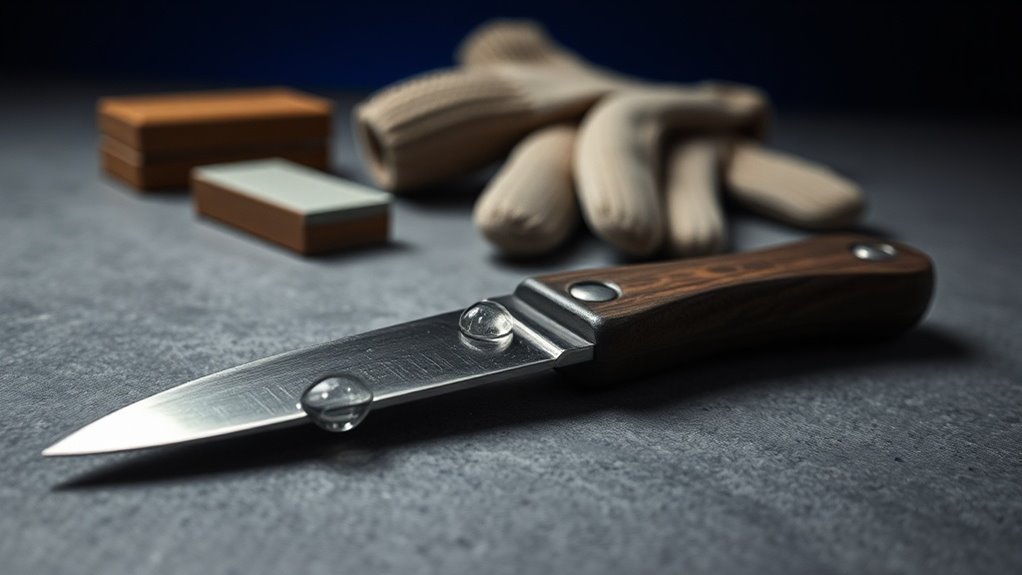
To keep your sharp tools in top condition, make sure you’ve got a regular inspection schedule in place. Proper storage techniques also play an essential role in maintaining their sharpness and safety. Regular maintenance, such as cleaning tools after each use, is crucial in extending the life of your tools. Let’s explore how these practices can help extend the life of your tools.
Regular Inspection Schedule
Establishing a regular inspection schedule for your sharp hand tools is crucial for maintaining safety and efficiency. By regularly checking your tools, you can quickly identify any wear, damage, or misalignment that could lead to accidents.
Here are a few key points to contemplate:
- Check for damage: Inspect blades for chips, cracks, or rust.
- Sharpen as needed: Ascertain tools maintain ideal sharpness for performance.
- Tighten fasteners: Make sure all screws and bolts are secure to prevent loosening during use.
- Clean regularly: Remove any debris or buildup to keep tools in top condition.
Proper Storage Techniques
Maintaining sharp hand tools isn’t just about inspection; proper storage is equally important to guarantee their longevity and safety. After use, store tools in a designated area, ideally in a toolbox or on a designated shelf. This prevents damage and keeps them organized, ensuring you can find what you need quickly.
Here’s a quick reference for effective storage techniques:
| Storage Method | Description |
|---|---|
| Toolboxes | Keep tools protected and organized. |
| Blade Guards | Use guards to prevent blade damage. |
| Magnetic Strips | A convenient way to store metallic tools. |
Make sure to regularly declutter your storage area to maintain an efficient and safe environment, and you’ll extend the life of your sharp tools.
Wearing Appropriate Personal Protective Equipment (PPE)
While using sharp hand tools, wearing appropriate personal protective equipment (PPE) is essential for ensuring your safety.
Even a small oversight can lead to serious injuries, so gear up properly before you start working.
Here are the key items you should consider:
- Cut-resistant gloves: Protect your hands from accidental cuts and lacerations.
- Safety glasses: Shield your eyes from flying debris and sharp objects.
- Steel-toed boots: Prevent foot injuries from dropped tools or equipment.
- Long sleeves and aprons: Guard your skin against cuts and abrasions.
Additionally, having a well-stocked first aid kit on hand can help address any injuries promptly.
Using the Right Cutting Technique
Using the right cutting technique is essential for your safety and effectiveness.
You’ll need to focus on proper grip methods, the angle of approach, and ensuring your cutting surface is stable.
These factors can greatly reduce the risk of accidents and improve your results.
Proper Grip Methods
A solid grip is essential when handling sharp hand tools to guarantee both safety and efficiency.
Using the right grip methods can prevent accidents and ensure precise cuts. Here are some key points to keep in mind:
- Hold tools firmly: Your grip should be secure but relaxed to avoid fatigue.
- Use your dominant hand: This allows for better control and accuracy.
- Keep fingers clear: Always position your fingers away from the cutting path to prevent injury.
- Position your body: Stand firmly with a balanced stance to improve leverage and stability.
Angle of Approach
Maintaining a proper grip on your sharp tools sets the stage for effective cutting, and the angle at which you approach your material plays a significant role in the outcome.
When you cut, aim for a slight angle rather than slicing straight down. This technique allows the blade to glide smoothly, reducing the risk of binding or chipping. You’ll want to maintain consistent pressure as you move through the material, ensuring the cut stays clean and controlled.
Additionally, keep your body positioned in a way that maximizes leverage without straining yourself. Remember, adjusting your angle can greatly impact not just the quality of your cut but also your safety.
Be mindful of your approach, and always prioritize precision in your techniques.
Cutting Surface Stability
Since a stable cutting surface is essential for safe and effective cutting, always make certain your workspace is secure before you begin.
An unstable cutting surface can lead to slips, mishaps, and injuries. Take the time to set up your area properly.
Here are some key points to take into account:
- Use a dedicated cutting board or mat to absorb force and prevent slipping.
- Ensure the surface is flat and firm to maintain control during cutting.
- Keep your workspace clutter-free; distractions can lead to accidents.
- Anchor materials securely to stop any movement while you’re cutting.
Ensuring a Safe Workspace Environment
Creating a safe workspace environment isn’t just beneficial; it’s essential for anyone working with sharp hand tools. Start by ensuring your workspace is well-lit and free from clutter. This minimizes distractions and reduces the risk of accidents.
Always maintain a non-slip surface; if you’re working in a particularly busy area, consider laying down mats to help with grip.
Make sure tools are easily accessible but not in the way. Position your workbench at a comfortable height, so you don’t strain while cutting. Keep all blades and sharp edges pointed away from your body and others nearby.
Additionally, consider keeping a first aid kit readily available. Your safety is paramount, so investing in a secure workspace is an easy and effective precaution. Following essential safety rules can help you build a strong foundation for safe tool usage.
Proper Tool Storage and Organization
A well-organized toolbox can make all the difference when working with sharp hand tools. Proper storage and organization not only keep your tools safe but also reduce the risk of accidents.
Here are some tips to help you maintain an efficient storage system:
- Use designated spots: Assign specific locations for each tool, making it easier to find what you need.
- Keep it clean: Regularly wipe down your tools and storage space to prevent rust and maintain visibility.
- Store blades safely: Use sheaths or covers for sharp edges to avoid accidental cuts when reaching for tools.
- Label drawers or sections: Clear labels help you and others quickly identify where tools belong.
Additionally, consider implementing proper storage containers like sheathes or holders to enhance safety and prolong the life of your tools.
Paying Attention to Surroundings
Even with a well-organized toolbox, your safety isn’t just about proper storage; it also involves being aware of your surroundings while you work. Pay close attention to people and obstacles around you. Distracted work can lead to accidents, so focus on what you’re doing.
| Danger Zone | Alertness Level | Action Needed |
|---|---|---|
| Unattended tools | High | Move them safely |
| Crowded workspaces | Medium | Clear the area |
| Distractions noise | Low | Reduce interruptions |
Staying mindful of these factors not only keeps you safe but also those around you. A simple moment of awareness can prevent a serious injury, allowing you to work effectively and confidently.
Educating Others on Safe Practices
Safety education is essential when working with sharp hand tools, as knowledge can greatly reduce the risk of accidents.
You can play a significant role in promoting safe practices among your peers. Here are some effective methods to educate others:
- Demonstrations: Show proper techniques for using tools safely.
- Create Checklists: Develop easy-to-follow safety checklists for different tools.
- Hold Workshops: Organize safety workshops to engage hands-on learning and discussions.
- Share Resources: Provide access to manuals, articles, and videos that highlight safe usage.
Recognizing When to Seek Help
Knowing when to seek help can be essential when using sharp hand tools, as attempting a task beyond your skill level can lead to serious injuries. If you’re unsure about a technique or tool, don’t hesitate to ask someone more experienced. Here’s a handy guide to contemplate:
| Situation | Action to Take |
|---|---|
| You’re unfamiliar with a tool | Ask for instructions or a demo |
| You feel rushed or pressured | Slow down and consult a colleague |
| You’ve sustained a minor injury | Seek medical advice and assess work |
Questions
What Should I Do if My Tool Becomes Damaged During Use?
If your tool becomes damaged during use, stop immediately. Inspect it for issues, and don’t attempt to fix it while it’s still in use. Consider replacing it or seeking professional repair before continuing.
How Can I Safely Transport Sharp Tools From One Location to Another?
To safely transport sharp tools, always securely store them in a protective case or sheath. Keep the sharp edges covered, and make sure they’re organized to prevent movement. Always carry them carefully to avoid accidents.
Are There Age Restrictions for Using Sharp Hand Tools?
Yes, there are typically age restrictions for using sharp tools. Most regulations require users to be at least 18 years old, but it’s essential to check local laws or guidelines for specific age requirements in your area.
How Can I Identify the Right Blade for Specific Materials?
Choosing the right blade’s like matching a shoe to a foot; it needs to fit! Look for blade types, tooth count, and materials compatibility. Researching or asking an expert guarantees you’ll slice through your projects effortlessly.
What Are the Signs of a Dull Tool Needing Replacement?
You’ll notice a dull tool if it struggles to cut, produces ragged edges, or requires excessive force. If you see those signs, it’s time to sharpen or replace it to maintain efficiency.
Conclusion
By following these safety guidelines, you’ll not only protect yourself but also enhance your skills with sharp hand tools—no need to channel your inner caveman! Remember to choose the right tool, maintain it well, and wear your PPE. Keep your workspace organized and stay aware of your surroundings. Educate others, and don’t hesitate to ask for help when you need it. Staying safe means you can enjoy your projects without worry—happy crafting!

